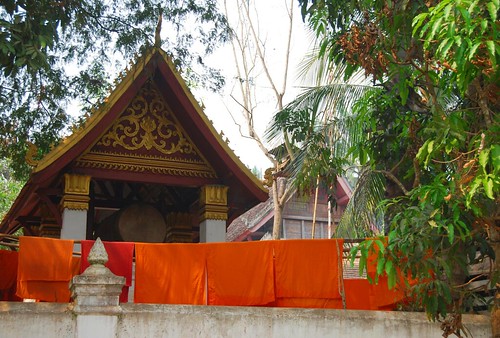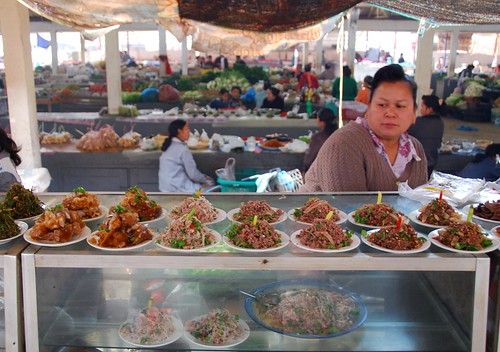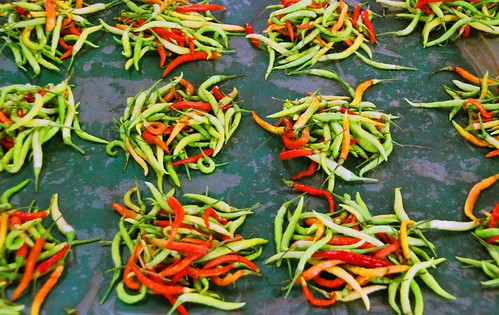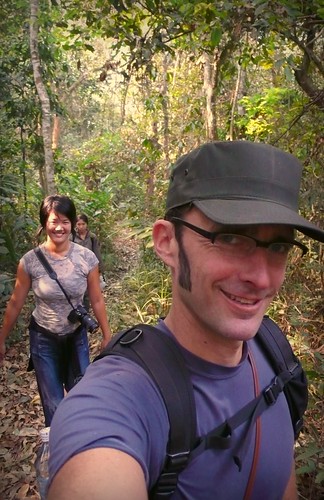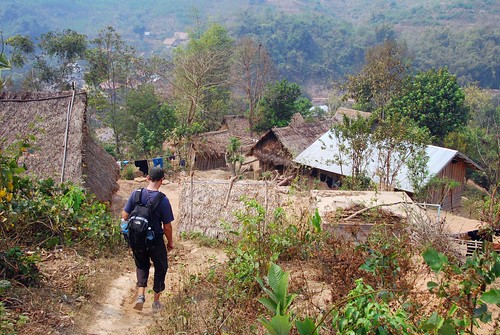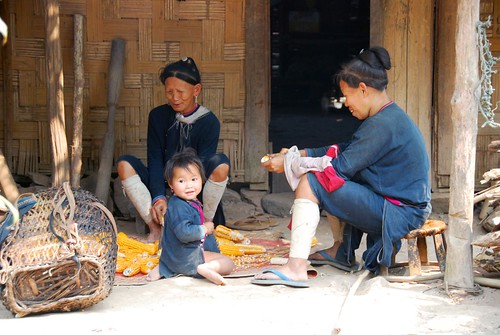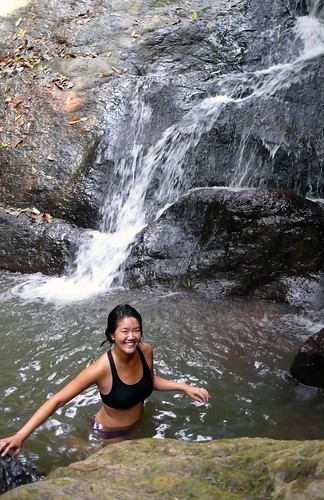Archive for April, 2009
If there is one thing you won’t want to do in Laos, it’s rush. We really didn’t get to spend enough time here or see that much of the country, but we were in Laos long enough to get the flavor of the place. And what exactly does Laos taste like? Dust. Sticky rice. Tranquility. Shyness. Noodle soup. Divinity. Poverty. Beerlao. Golden sunsets. And, if it is possible to taste such a thing, the flavor of time standing still.
Day spent here: 7
Places we visited: Luang Prabang, Luang Nam Tha
Places we would like to visit next time: Southern Laos, especially Champasak and Si Phan Don
Prices: We found the prices in Luang Prabang to be quite high. It is possible to find cheap accommodation and food, but it’s no fun eating at the market every night. Every so often, you want to eat in a restaurant, and in LP, that can set you back about US$5-10 per person. On the other hand, Luang Nam Tha was quite cheap…we paid 60,000 kip (approx. US$7) for our room, and dinners at the local restaurant were only about US$3-5 each (even cheaper for a bowl of noodles at the LNT night market).
Similar to Vietnam, prices in Laos are often quoted in US dollars, though you can pay with dollars, kip, or even Thai baht. The exchange rate was US$1 = 8,500 kip.
Weather: While we were in Laos (early March), it was nothing but HOT. There was not a whisper of wind to speak of, and combined with the smoke in the air, it made the heat very oppressive.
Transit: We traveled only by public bus in Laos…there were no other options to the areas we were headed (Luang Prabang to Luang Nam Tha, and Luang Nam Tha to the border town of Huay Xai).
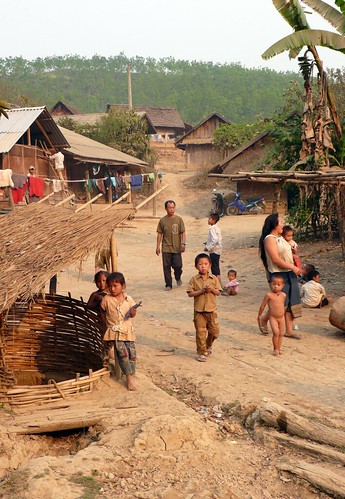
Village kids running to gawk at us on the public bus. Somwhere between Luang Nam Tha and Huay Xai.
Laotian public buses are old are they are notorious for breaking down, though luckily, this never happened to us. The roads are not exactly in the best condition, so bus rides are typically very long and bumpy. Also, Laotian public buses do not have air conditioning, so the windows are left open, leaving you and your lungs covered in layers of Laotian dust.
Internet: Our free Internet spree ended once we boarded the plane in Hanoi. Wireless internet was available in Luang Prabang, usually for about 10,000 kip per hour. Connection speeds were quite slow, however. There was no wireless in Luang Nam Tha.
Food and drink: You have not had Laotian food until you have had sticky rice. It is served in a woven bamboo basket and eaten with the hands (you pull out a chunk, and pinch your meat/vegetables between the sticky rice).
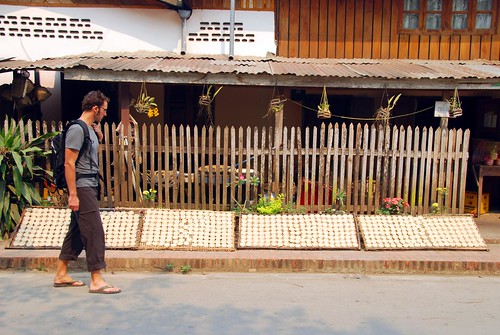
Jeremy walking by some sticky rice cakes drying in the sun, Luang Prabang.
Otherwise, Laotian food is very similar to Thai food. Their rice noodle soups are tasty! Also, the bread in Laos is incredible. Vietnamese French bread is very airy, but Laotian bread is dense, more similar to the bread in France. For lack of a better way of describing it, the bread in Laos seemed more “gourmet.” In Luang Prabang, we found these Laotian sandwiches at the market that were stuffed with grilled chicken, tofu, lettuce, cucumber, and then drizzled with sweet chili sauce. At 10,000 kip (approx. US$1.20) per sandwich, these sandwiches were our tasty, cheap, and filling lunch treats on many LP days.
Similarly, you cannot leave Laos without drinking Beerlao. That’s not a command, it’s an actuality…I am not sure if you an even get any other beers in small Laotian towns! It’s cheap, too…about 12,000 kip for a big bottle which you can split amongst two (or not, depending on how much you drink). ![]()
Culture: Laotians are a very shy and reserved (but sweet) people. Coming from Vietnam, it can be both a positive and negative culture shock; positive because everyone pretty much leaves you alone (which is nice after being constantly harassed to spend your money on this or that in Vietnam), but negative because it is harder to get to know the people here. I think that’s why it’s a good idea to linger a while in Laos, it seems like the kind of place that grows on you (and vice versa). Unfortunately, we just didn’t have enough time to spend here.
That reserved nature carries itself into the culture in other interesting ways…for instance, all around town (in both LP and LNT), there are signs posted in English explaining how Westerners should behave in Laos (i.e., don’t point the bottom of your feet at Buddhas, public displays of affection are frowned upon, women should not touch monks, etc.). Laotians (or at least the government) seem very interested in preserving Laotian culture (though we’ve heard rumblings that this could be due to paranoia rather than any lofty cultural goals—apparently the government is ever-wary of the US invading its social, cultural, and governmental structures, even though most Americans would most likely not be able to point Laos out on a map).
In other ways, though, we found Laos to be quite progressive. Certainly the artisan culture is very alive here and we were pleasantly surprised by the quality and variety of souvenirs and trinkets aimed at the tourist market. Whereas in other SE Asian countries the offerings were limited to cheap plastic sunglasses and logo t-shirts, in Luang Prabang, we saw beautiful embroidered quilts, woven tapestries, and handmade books.

Textile weaver in Ban Phanom village outside of Luang Prabang.
In short: Most travelers probably love Laos because, unlike other SE Asian countries, the people will just leave you be and let you enjoy the country without their intervention. I will admit that Laos’ peaceful nature is really seductive, but on the other hand, chance encounters with locals is what makes a place really special (for me anyway)—I treasure the opportunity to learn about their world through their eyes. Since Laotians are naturally more reserved, it can take a while to figure out how to get them to open up to you. I wish we had more time to spend in this lovely country, a week was not enough time to lure Laos out of its shell.
While most people spend their days in southern SE Asia lying around on pristine beaches, drinking fresh fruit shakes, and snorkeling in warm ocean water, the north’s main activity is trekking, usually to hill-tribe minority villages. Multi-day treks are very popular in northern Vietnam, Laos, and Thailand. We had such an amazing time on our Sapa trek, we decided to head north from Luang Prabang towards Luang Nam Tha, a small town that doesn’t seem to have much going on for it except that it makes a convenient base for exploring the nearby Nam Ha National Protected Area (NPA). LNT has been celebrated for its commitment to ecotourism principles…local tour agencies not only limit the number of trekkers in a group in order to diminish the impact on the environment, but they ensure that a large percentage of the trek fee (usually about 30%) goes towards the village, and each agency offers completely different trek routes so that money coming into the area is distributed fairly amongst the minority tribes. Sounds awesome, huh?
Well, it was and it wasn’t. From what we understand, the LNT tourism industry is still in its infancy, and there were some odd practices in place that didn’t really gel with us—namely, the pricing system. Basically, the more people that sign up for a trek, the less each individual in the group needs to pay. Basically, this means that when you sign up for a trek, you have no idea how much you will end up paying for it. You might pay US$60 each if it’s just two of you, or as little as US$25 each if 6 more people sign up after you. It’s really frustrating.
What ends up happening is that people searching for treks wander around from agency to agency, looking for a trek that already has other people signed up. And since LNT is not super heavily touristed, everyone waits and waits until another person or couple signs up before they sign up, in order to ensure that they will not pay top dollar for their tour.
So, we waited all day hoping that another person or couple would sign up for a two-day tour. At 7PM, when no one had signed up yet, we finally gave up and booked a tour. BUT, because it would have been really expensive (like US$75 each) for a two-day trek (since it was only the two of us), we decided just to do a day hike. In retrospect, we should have signed up EARLIER in the day rather than later, so that other people playing the same waiting game might have signed on to our trek.
Annoying, dontcha think?
We met our tour guide Noo (pronounced “no-oh”) in the morning, and she was very shy. Laotians in general are very reserved, extremely polite people (which is VERY different from the rest of SE Asia). Our first stop was the local market, where (we found out later) Noo was picking up our lunch.
We were absolutely amazed by the market…it was clean, organized, quiet, and odor-free; quite an enormous change from the other markets we had been to in SE Asia. I mean, the produce was all organized into little piles! The butcher area had all the assorted animal parts, but there was not even a hint of smell! Even the dirt floor looked swept-clean somehow.
Even weirder: as I was wandering around the market, I saw a family selling bamboo shoots…and some small (dead) songbirds, a mouse, and what looked like a ferret or long squirrel. I took a photo and the family quickly covered the dead animals up under palm leaves (If you want to see the photo, click here, I won’t post it in case someone out there is squeamish about seeing a dead ferret/squirrel thingy). I thought maybe they had hunted these animals illegally, but Noo thought they were just embarrassed. We have seen some really, really weird stuff for sale in SE Asia markets (remember the “ba”?) and nobody has ever tried to hide anything from our cameras. This was like a Bizarro market!
After the market, we headed out to a local village to start our trek. The drive was stunning…a gorgeous landscape of rice paddies studded with bamboo shacks.
We walked through a dusty village and headed into a dusty forest. Little did we know that the great majority of our hike would be within this dense cover. I mean, isn’t the point of a hike to see stuff? Noo did point out local fruits and bird feathers and that sort of thing, but we didn’t see much for several hours except dusty trail and trees. When we did get to a clearing, the smoke was so thick from the local slash-and-burn agriculture that we couldn’t see very far anyway.
At some point, Noo told us it was lunch time and she ran off into the forest. We were sitting there wondering what she was doing when she came back with a handful of palm leaves, which would become our lunch table.

Our lunch spread of roasted duck, bamboo shoots, river weed (I wasn’t crazy about this), and sticky rice.
Finally, we were out of the forest and descending into a village. Now we’re talking!
We saw a little cutie helping her family de-kernel some corn.
The village was small and it only took us about 10 minutes to walk through it on our way to the local waterfall. The waterfall was cool…there were dozens of tiers ending in small pools where you could go for a swim. Noo led us all the way up to what seemed like the very furthest pool (which is good, the water is cleaner upriver). The water was really cold, so I did my usual thing of getting in really, really slowly (I know it hurts more that way, but I can’t help it). Noo surprised both me and Jeremy by yelling, “Here, let me help you!” and splashing me! This quiet, reserved girl who had said maybe 3 words on her own the entire trek was now showering me with cold water! Well, it worked, I finally got in. ![]()
So, that was out experience in Luang Nam Tha. I don’t really feel like we saw much and we kinda paid a lot for it (our day trip was US$37 each, I think…for reference, we paid US$23 for two days in Sapa). Noo was sweet but she ain’t no Thuyen. ![]() I’m kinda glad that we didn’t end up doing a 2-day trek because I’m not sure if the scenery would have been much better. Jeremy and I both think the 2- and 3-day trekking trails probably just meander through more dusty forest (though you would get to stay in a village for the night).
I’m kinda glad that we didn’t end up doing a 2-day trek because I’m not sure if the scenery would have been much better. Jeremy and I both think the 2- and 3-day trekking trails probably just meander through more dusty forest (though you would get to stay in a village for the night).
I guess the lesson here is, if you ever go to LNT:
1. Sign up early in the day for the trek YOU want; someone else will probably follow.
2. Don’t go during burning season.
I think you could safely say that our experience in LNT was kind of a bust. We really admire the commitment to sustainable and fair tourism here, but let’s just hope they work out the kinks so that people who make the effort to get out to LNT can spread the word.
